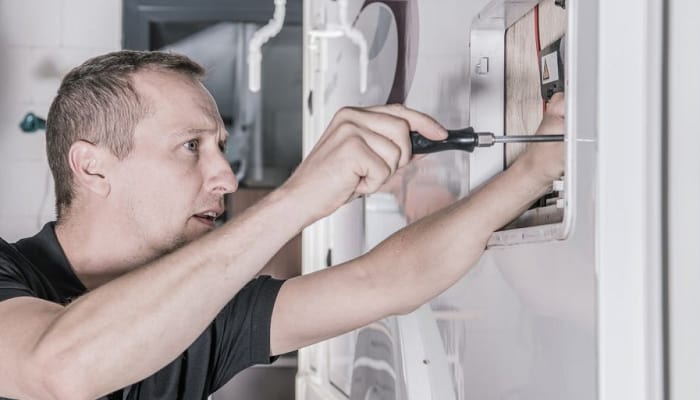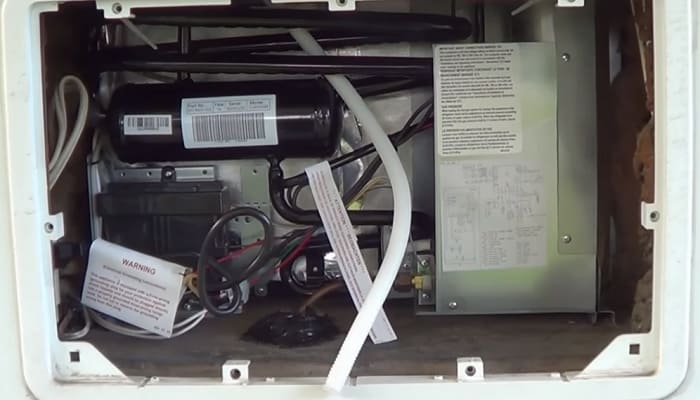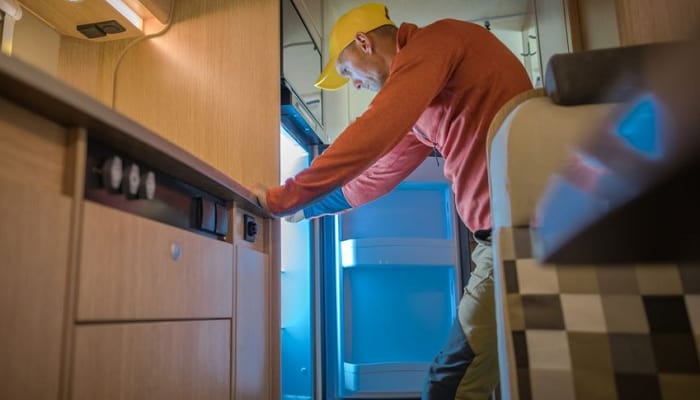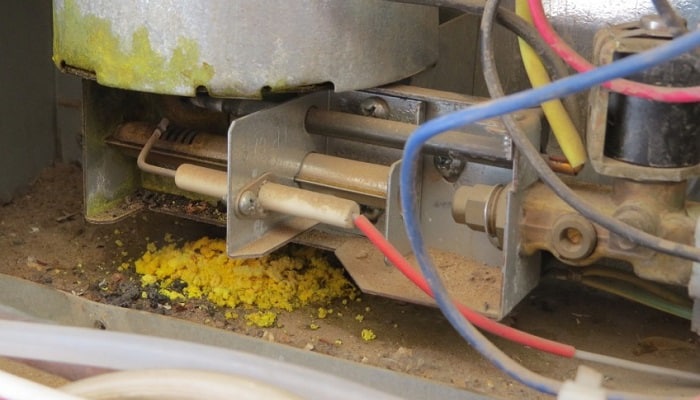One of the most important features in RVs, both modern and from a couple of decades ago, is the refrigerator. If you are an avid RVer, then you might not be able to imagine a trip without your trusty old refrigerator. Without it, the only foods that you can bring with you on your trips are those in cans and a couple of pounds of jerky.
It is, therefore, important for you to know how to check the ammonia level in the RV fridge before embarking on your latest trip. One of the biggest telltale signs that your refrigerator may be on the fritz is if you get a whiff of ammonia, even if you did not use any kind of ammonia-based cleaner on it.
The reason for this is that most portable refrigerators, like those found in RVs, work using ammonia-based coolants instead of CFC or HFC. So when you smell ammonia from your fridge, there must be a leak in your coolant system. In such a case, you have to deal with it immediately to minimize the extent of the damage.
Table of Contents
Why Use Ammonia?
Well before the development and use of modern refrigerants, refrigerator makers used ammonia as coolants. This provided early homeowners with a more efficient way to keep their perishable foods fresh for longer.
Even though ammonia is no longer as popular as it was back then, some fridge makers still use it, mainly for miniature fridges and portable ones used for RVs. One of the biggest reasons why ammonia was popular as a refrigerant is because of its smell.
When you get a whiff of ammonia, you already know that there is a leak in the pipes. The immediate repair will prevent the problem from getting worse and extend the usable lifetime of the fridge.
Pros and Cons of Using Ammonia
Although using ammonia as a refrigerant comes with a lot of benefits, there are reasons why it is replaced by modern refrigerants in most modern refrigerators these days. Here is a list of some of the most common pros and cons of using ammonia-based refrigerants:
Pros:
Inexpensive – Aside from the fact that it is easily detectable by smell, ammonia production is quite cheap and is also very efficient as a refrigerant. This is the reason why it was so popular in the early days of modern refrigeration.
Energy-efficient – Unlike modern refrigerators that use the standard compression and expansion cycles, ammonia-based refrigerators work based on temperature fluctuations. This makes them use very little amounts of electricity.
Cons:
Corrosive – Ammonia is highly-corrosive. If it leaks and gets in contact with any kind of surface, it will most likely leave a stain.
Slightly toxic and flammable – Ammonia can be quite toxic. This means that if there is a leak, they can be contaminated and will need to be disposed of immediately. It is also flammable when exposed to oxygen, which is why modern domestic refrigerators are now using less flammable and less toxic refrigerants.
Safety Concerns
Ammonia vapors can irritate the skin, eyes, nose, and throat. When you catch even a small whiff of ammonia in your RV, open all the windows and doors to increase the ventilation inside and remove the fumes.
If the ammonia fumes have gotten too overwhelming, get out of the RV and rinse out all the irritated parts with lots of clean, cold water until the irritation has settled. If the irritation persists, go see a doctor immediately.
If you will be handling the repairs of the refrigerators yourself (you will learn more about this later), it is recommended to use a pair of thick rubber gloves. If your skin gets in contact with strong ammonia, it will cause skin irritation.
Getting Rid of the Lingering Smell
If there is still a bit of the ammonia smell left even after the refrigerator has been repaired, you can get rid of it by placing a couple of saucers of fresh coffee grounds inside the fridge for a day. Alternatively, you can also place a couple of big chunks of wood charcoal inside the fridge. These two items will absorb all the smells in the fridge and keep it smelling fresh.
How to Fix a Leaking Ammonia-based Refrigerator?
Having a fridge in your RV can be very convenient especially when you are going on long interstate trips. However, when it breaks down, having it repaired can be expensive. If you smell ammonia coming from the fridge and you notice that there are yellow stains in and around it, then that means there is a leak in the fridge’s main cooling unit.
Unfortunately, the only way to fix this is to replace the entire unit with a brand new or refurbished unit. Although replacement parts are expensive, you can lessen the load on your wallet by doing the actual repairs yourself.
It is pretty easy to replace the main cooling unit. You just need a bit of technical know-how, some basic tools, and a couple of hours of your spare time. Here are the steps that you need to follow:
- Take off the refrigerator from its mount in the RV fridge cabinet. Take the fridge outside and set it upright.
- If there are ammonia spills, wipe it off using a damp rag. Remember to wear thick rubber gloves to prevent the ammonia from getting in contact with your skin.
- Grab your Phillips-head screwdriver and take off the screws on the evaporator fins and burner assembly cover. This will allow you to take off the back cover.
- Set the fridge with its front on the ground so the exposed cooling unit is facing up. Unscrew the mounting screws holding the cooling unit in place and carefully pull it out and prepare it for disposal.
- Remove all of the dried thermal mastics that remain inside the fridge cavity.
- Grab the new cooling unit. Using a wood rasp (you can use a utility knife if you do not have a rasp), shave off enough of the foam encasing the new cooling unit so that it can fit snug inside the refrigerator. Slide the new unit inside the refrigerator. Check if the fins lie flush against the evaporator tubes. Once you are happy with the fit, pull out the unit from the fridge.
- Snip the corner off the bag of thermal mastic that came with the new cooling unit. Apply thermal mastic in half-inch increments on all the exposed evaporator tubes.
- Slide the new cooling unit inside the refrigerator frame carefully. Press down on the unit using medium pressure for about a minute to give the thermal mastic time to adhere to the two units together.
- Replace the cover and the fins of the refrigerator and set the refrigerator upright. Leave it in place to ensure that there are no new leaks in the cooling unit. If everything seems fine then put the refrigerator back in its mounting place in the RV.
How to Use your Refrigerator Efficiently?
It is also important to learn how to use your RV refrigerator efficiently, so it can serve its purpose for a long time. One thing that you should do is to avoid leaving your refrigerator running while you are driving towards your campsite. The fridge can still keep your food nice and cold for a couple of hours but you need to start with a very cold refrigerator.
One day before your RV trip, turn on the refrigerator. The night before your trip, set the thermostat to the lowest possible setting. Turn off the refrigerator just before you embark. Fill all empty spaces in the fridge with cold drinks. Before you turn off the fridge, make sure that all of the contents are already cold.
Room temperature items will quickly sap all of the cold left inside the refrigerator. Also, avoid opening the refrigerator if you do not need to. Every time you open the fridge door, you are letting hot air inside, making it less efficient in keeping the contents cold until you reach your campsite.
To prevent yourself from opening the fridge every so often, prepare a cooler full of beverages and have some snacks on hand. If you need to open the fridge, think ahead about what you need to take out. This will greatly minimize the length of time the fridge door remains open.
Conclusion
The RV fridge is one of the most important appliances that you can take with you, especially on long trips. This allows you to enjoy fresh foods with you wherever you go. This is why when you start to smell a slight ammonia scent coming from the fridge, you have to get it repaired immediately.
That ammonia smell that you are getting comes from the refrigerator’s cooling unit. There might be a small leak that causes the ammonia-based refrigerant to pour out. If caught early on, the cooling unit can still be salvaged. However, if there are already ammonia stains and ammonia pooling outside the refrigerator, there is no other choice but to replace it completely.
It is quite easy to replace the cooling unit if you need to and you can save a lot of money by doing the job yourself. If you know how to check ammonia level in RV fridge and you found that your cooling unit is already faulty, you can just replace it yourself.

Hi, I am Tom Hank, an RV-er since 2014. Back then, I started without much help. As you can imagine, the struggles are endless. But now, you do not have to begin your adventures knowing next to nothing about RV lives.





